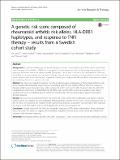| dc.contributor.author | Jiang, Xia | en_US |
| dc.contributor.author | Askling, Johan | en_US |
| dc.contributor.author | Saevarsdottir, Saedis | en_US |
| dc.contributor.author | Padyukov, Leonid | en_US |
| dc.contributor.author | Alfredsson, Lars | en_US |
| dc.contributor.author | Viatte, Sebastien | en_US |
| dc.contributor.author | Frisell, Thomas | en_US |
| dc.date.accessioned | 2017-01-03T23:50:04Z | |
| dc.date.issued | 2016 | en_US |
| dc.identifier.citation | Jiang, Xia, Johan Askling, Saedis Saevarsdottir, Leonid Padyukov, Lars Alfredsson, Sebastien Viatte, and Thomas Frisell. 2016. “A genetic risk score composed of rheumatoid arthritis risk alleles, HLA-DRB1 haplotypes, and response to TNFi therapy – results from a Swedish cohort study.” Arthritis Research & Therapy 18 (1): 288. doi:10.1186/s13075-016-1174-z. http://dx.doi.org/10.1186/s13075-016-1174-z. | en |
| dc.identifier.issn | 1478-6354 | en |
| dc.identifier.uri | http://nrs.harvard.edu/urn-3:HUL.InstRepos:29739132 | |
| dc.description.abstract | Background: To prevent debilitating and irreversible joint damage, rheumatoid arthritis (RA) is often treated with tumor necrosis factor inhibitor (TNFi), but many patients do not respond to this costly therapy. Few predictors for response are known, and it has been proposed that genetic factors which influence the development of RA may also influence disease severity and response to therapy. Several previous studies have attempted to confirm this but results remain inconclusive. We expand on previous studies by including more RA risk alleles, and maximize power by combining them into a genetic risk score. Method We linked genotyped RA patients from the Epidemiological Investigation of Rheumatoid Arthritis study to the Swedish Rheumatology Quality Register, identifying patients who started a TNFi as their first biological disease-modifying anti-rheumatic drug, with a return visit within 2–8 months after treatment start (N = 867). We calculated risk scores from 76 established RA risk SNPs, and four HLA-DRB1 amino acid positions, and tested whether risk scores or individual genetic risk factors could predict the European League Against Rheumatism (EULAR) response. Results: We found no association between any of the risk scores or HLA-DRB1 haplotypes and EULAR response, neither overall nor stratified by anti-citrullinated protein/peptide antibody (ACPA) status. When evaluating each of the 76 SNPs, we found that the number of SNPs presenting significant associations was not higher than expected by chance (5/76 SNPs had p < 0.05 in ACPA-positive RA, 4/76 in ACPA-negative RA). Conclusion: Overall, known RA risk SNPs do not predict response to TNFi, either individually or when combined into a risk score. This does not support the hypothesis that genes influencing RA onset would also influence its prognosis and treatment response. Electronic supplementary material The online version of this article (doi:10.1186/s13075-016-1174-z) contains supplementary material, which is available to authorized users. | en |
| dc.language.iso | en_US | en |
| dc.publisher | BioMed Central | en |
| dc.relation.isversionof | doi:10.1186/s13075-016-1174-z | en |
| dc.relation.hasversion | http://www.ncbi.nlm.nih.gov/pmc/articles/PMC5135751/pdf/ | en |
| dash.license | LAA | en_US |
| dc.subject | Rheumatoid arthritis risk SNPs | en |
| dc.subject | HLA-DRB1 haplotypes | en |
| dc.subject | Tumor necrosis factor inhibitor prediction | en |
| dc.subject | Genetic | en |
| dc.title | A genetic risk score composed of rheumatoid arthritis risk alleles, HLA-DRB1 haplotypes, and response to TNFi therapy – results from a Swedish cohort study | en |
| dc.type | Journal Article | en_US |
| dc.description.version | Version of Record | en |
| dc.relation.journal | Arthritis Research & Therapy | en |
| dash.depositing.author | Jiang, Xia | en_US |
| dc.date.available | 2017-01-03T23:50:04Z | |
| dc.identifier.doi | 10.1186/s13075-016-1174-z | * |
| dash.contributor.affiliated | Jiang, Xia | |


